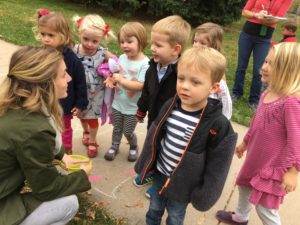Story by Diana Purtz
“You don’t have to have a disability to benefit from occupational therapy,” says occupational therapist and CSU Assistant Professor Lisa Fyffe. “Occupational therapists can support the playfulness, development and learning of all children in small and large ways.”
Through a growing partnership between CSU’s Occupational Therapy program and the CSU Early Childhood Center, part of the Department of Human Development and Family Studies, Fyffe has been instrumental in instructing occupational therapy students and early childhood educators on occupational therapy’s potential to affect typically developing children during the first five years of life.
 This way of thinking represents a shift in traditional pediatric occupational therapy practice and education. Rather than waiting for developmental delays to emerge in elementary school, occupational therapists are positioned to identify children early on who may be falling behind in their development and provide immediate support.
This way of thinking represents a shift in traditional pediatric occupational therapy practice and education. Rather than waiting for developmental delays to emerge in elementary school, occupational therapists are positioned to identify children early on who may be falling behind in their development and provide immediate support.
Why wait?
“Children with learning disabilities show differences in their development as early as six months of age,” explains Fyffe. “If we can see it at six months of age, why wait until first grade to do something about it?”
Occupational therapy is a natural fit within the ECC, since the profession focuses on child development and learning through the experience of play. Because the ECC is a Reggio Emilia-inspired lab school, the mindset integrates well with the school’s philosophy and approach to early childhood education.
“Our lessons focus on the children’s interests.,” reported Jessica Knudsen, an ECC teacher. “They can grow their social-emotional skills through activities like painting, as there is no wrong way to do art.”
She added that a lesson on abstract art culminated in a child-led art exhibit.
Knudsen also described the school’s emphasis on using natural environments to foster fun and respectful childhood engagement. For example, children spend much of their day outside, self-directing their play. This encouragement of naturalistic self-expression creates a welcoming, playful, imaginative and laughter-filled school for children ages 6 weeks to 6 years. The ECC and CSU’s OT program collaborate to enhance children’s abilities to play and to embrace the whimsical nature of childhood to promote learning and meaningful educational experiences in a healthy, caring, natural environment.
Squirrel activity
Sunny Karges, an occupational therapy fieldwork student at the ECC, recently led an activity with the preschool classrooms designed to target the children’s emerging development of balance and body sense through the context of play. The activity involved “squirrel trick-or-treating,” where children climb onto soft steps of varying heights to place acorns and seeds into pumpkin buckets for the many squirrels that frequent the playground at ECC. The occupational therapist’s eye captures the engagement and ability of each child, and support is given to ensure that all children are challenged but also successful.
Occupational therapy at the ECC is health and wellness-based, so the occupational therapy students consult with teachers about children who may be showing behaviors outside the norm for their peers and provide individual, small-group and school-wide programming to enhance development of children across age ranges.
Working collaboratively to complement one another’s professional knowledge, the teachers and occupational therapists are showing that they can blend best practice in early childhood education with best practice in health promotion to provide a dynamic learning environment where every child is supported as they learn, play and grow.
The Departments of Occupational Therapy and Human Development and Family Studies are part of CSU’s College of Health and Human Sciences.